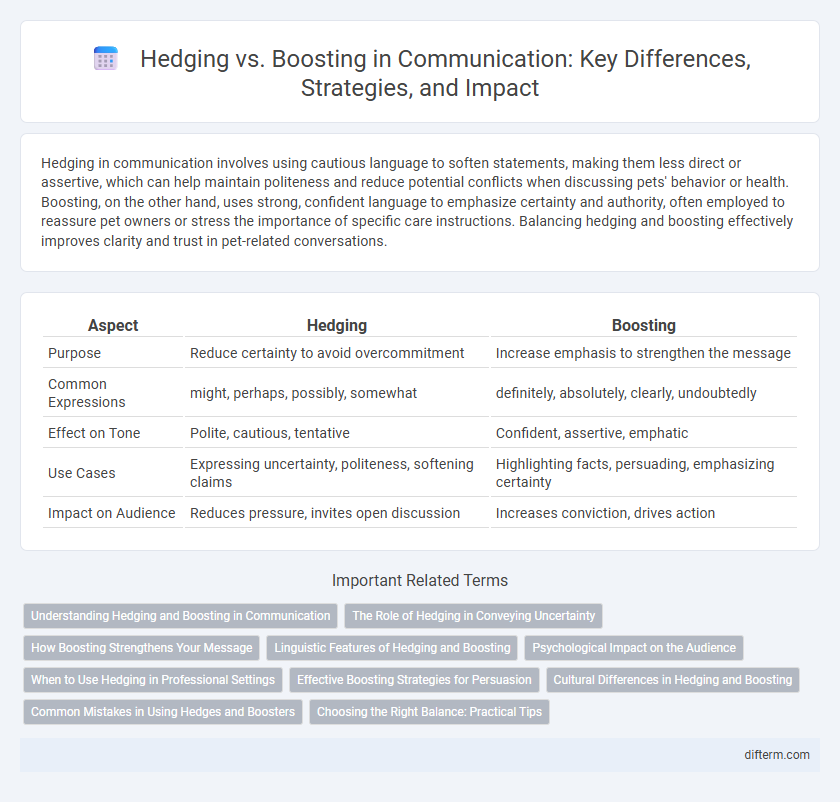Hedging in communication involves using cautious language to soften statements, making them less direct or assertive, which can help maintain politeness and reduce potential conflicts when discussing pets' behavior or health. Boosting, on the other hand, uses strong, confident language to emphasize certainty and authority, often employed to reassure pet owners or stress the importance of specific care instructions. Balancing hedging and boosting effectively improves clarity and trust in pet-related conversations.
Table of Comparison
| Aspect | Hedging | Boosting |
|---|---|---|
| Purpose | Reduce certainty to avoid overcommitment | Increase emphasis to strengthen the message |
| Common Expressions | might, perhaps, possibly, somewhat | definitely, absolutely, clearly, undoubtedly |
| Effect on Tone | Polite, cautious, tentative | Confident, assertive, emphatic |
| Use Cases | Expressing uncertainty, politeness, softening claims | Highlighting facts, persuading, emphasizing certainty |
| Impact on Audience | Reduces pressure, invites open discussion | Increases conviction, drives action |
Understanding Hedging and Boosting in Communication
Hedging in communication involves using cautious language to reduce the force of a statement, enhancing politeness and uncertainty management, while boosting employs emphatic expressions to strengthen claims and convey confidence. Effective use of hedging and boosting balances clarity and diplomacy, facilitating respectful and persuasive interactions. Mastery of these techniques improves interpersonal and professional communication by aligning message tone with audience expectations.
The Role of Hedging in Conveying Uncertainty
Hedging plays a crucial role in communication by signaling uncertainty and allowing speakers to express caution or politeness when presenting information. It enables the softening of statements through words like "possibly," "might," or "seems," which helps manage interpersonal dynamics and maintain social harmony. This strategic use of hedging contrasts with boosting, which strengthens assertions and conveys confidence or certainty.
How Boosting Strengthens Your Message
Boosting strengthens your message by emphasizing confidence and certainty, making your communication more persuasive and assertive. It employs strong, definitive language that reduces ambiguity and enhances clarity, helping the audience trust your statements. This approach is especially effective in professional and persuasive contexts where establishing authority and credibility is crucial.
Linguistic Features of Hedging and Boosting
Hedging in communication often employs modal verbs like "might" or "could," adverbs such as "possibly" or "somewhat," and vague nouns and verbs, which collectively soften statements and express uncertainty or politeness. Boosting utilizes intensifiers like "definitely," "clearly," and absolute terms such as "always" or "completely" to strengthen assertions and convey confidence. The strategic use of these linguistic features directly influences the perceived assertiveness and politeness of discourse in various communicative contexts.
Psychological Impact on the Audience
Hedging in communication softens statements, reducing perceived confidence but increasing approachability and openness, which can foster trust and lower listener resistance. Boosting strengthens assertions, enhancing credibility and authority, yet may intimidate or alienate audiences if overused. Effective speakers balance hedging and boosting to optimize persuasion while managing the audience's psychological comfort and receptivity.
When to Use Hedging in Professional Settings
Hedging is essential in professional communication when expressing uncertainty or politeness, particularly during negotiations, presentations, or feedback sessions to maintain diplomacy and reduce potential conflict. It is effective when conveying opinions, approximations, or tentative conclusions without appearing overly assertive or absolute. Using hedging phrases like "it seems," "possibly," or "suggests" helps balance confidence with openness in collaborative environments.
Effective Boosting Strategies for Persuasion
Effective boosting strategies for persuasion include using confident language that emphasizes certainty and strength, such as assertive verbs and positive adjectives. Highlighting clear evidence, statistics, and credible sources reinforces the message and enhances the speaker's authority. Employing repetition of key points and direct calls to action further solidifies the persuasive impact and motivates audience response.
Cultural Differences in Hedging and Boosting
Hedging and boosting strategies vary significantly across cultures, reflecting differing communication styles and social norms. In high-context cultures such as Japan and China, hedging is commonly used to maintain harmony and avoid direct confrontation, while low-context cultures like the United States favor boosting to express confidence and assertiveness. Understanding these cultural differences is crucial for effective intercultural communication and minimizing misunderstandings.
Common Mistakes in Using Hedges and Boosters
Common mistakes in using hedges and boosters often include overuse, which can dilute the message's clarity and weaken the speaker's credibility. Another frequent error is inappropriate placement, where hedges confuse whether the statement is a fact or opinion, while excessive boosting may come across as exaggeration or insincerity. Effective communication requires a balanced use of hedges and boosters to accurately convey certainty and nuance without misleading the audience.
Choosing the Right Balance: Practical Tips
Choosing the right balance between hedging and boosting enhances communication effectiveness by adapting message strength to audience expectations and context. Employing hedging techniques like modal verbs or cautious language can build trust and reduce misunderstandings in sensitive situations. Boosting strategies, such as assertive statements and confident tone, assert credibility and emphasize key points without alienating listeners.
hedging vs boosting Infographic

 difterm.com
difterm.com